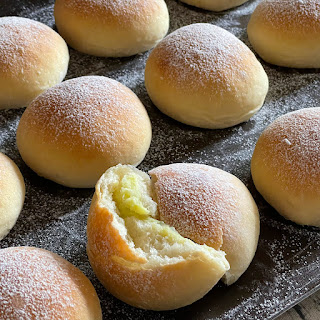Besides the popular egg custard, I have tried filling my coffee milk buns with coffee milk custard. In search of new flavour custard, I have tried Japanese melon milk custard with pandan flavour sago pearls for this new recipe. Really delicious if you like melon and pandan flavours.
The buns were baked at low temperature to keep their softness, but also to minimize the caramelized crust from over-powering the light and sweet aroma of the filling 💗💗💗
Yield: 12 small buns
Raw dough weight: 603g
1st proofing: overnight in fridge
Thaw for 100 minutes before shaping
2nd proofing: 40 minutes
Baking temperature: Preheat oven to 180℃, middle rack, bake at 180℃ for 3 minutes, lower to 170℃ for 10 minutes, reduce to 150℃ for 3 minutes, finally turn off oven and continue to bake for 2 minutes, or till crust turns lightly golden brown.
Raw dough weight: 603g
1st proofing: overnight in fridge
Thaw for 100 minutes before shaping
2nd proofing: 40 minutes
Baking temperature: Preheat oven to 180℃, middle rack, bake at 180℃ for 3 minutes, lower to 170℃ for 10 minutes, reduce to 150℃ for 3 minutes, finally turn off oven and continue to bake for 2 minutes, or till crust turns lightly golden brown.
Melon Milk Pandan Sago Custard Filling
265g collected
Click above sub-title to access to recipe link👆
Ingredients
20g hot water
20g raw sugar
25g top flour
10g potato starch
60g melon flavoured low-fat milk
50g whipping cream
20g condensed milk
1 egg
15g sago pearls
1 blade pandan leaf
20g hot water
20g raw sugar
25g top flour
10g potato starch
60g melon flavoured low-fat milk
50g whipping cream
20g condensed milk
1 egg
15g sago pearls
1 blade pandan leaf
Milk Bread Dough
Ingredients
230g bread flour
30g superfine wholegrain flour
5g pumpkin powder
30g raw sugar
2g instant dry yeast
50g natural yeast/sourdough, 100% hydration*
30g yudane dough^
150g low-fat milk, cold
10g condensed milk
5g whipping cream
10g beaten egg
25g cold water, to be added depending on dough condition
3g low sodium salt
20g unsalted butter, softened
* 50g natural yeast can be replaced by 25g each of bread flour and water + 1/8 tsp instant dry yeast. Let the mixture stand for about 1 hour or more till it doubles in volume, before use. You can also keep the mixture in the fridge overnight and thaw it for 1 hour before use.
^ 30g yudane dough is prepared by combining 16g of bread flour with 16g of very hot or boiling water into a sticky dough. Wrap the yudane dough in cling wrap, and cool down before use. Use a silicone spatula to scrape out the sticky yudane dough from the cling wrap.
Directions:
1. Knead the dough following your preferred method.
For my method, you can refer to my recipe Yudane Milk Bread. After kneading the dough to window pane stage,
2. After kneading the milk dough to window pane, shape the milk dough into a ball, and keep in a plastic bag coated with a little cooking oil. Keep the dough in the fridge overnight.
3. In the next day, remove the outer plastic bag, and let the dough thaw at room temperature for about 90 to 100 minutes.
4. Divide the dough into 12 portions, about 50g each, shape into balls and let them rest for about 15 minutes.
5. Roll flat a dough, scoop about 20g of melon milk pandan sago filling to the center. Wrap up the dough and shape into a ball.
6. Arrange the shaped dough over the baking pan. Spray some mist over, and let the shaped dough proof in a cold oven for about 40 minutes.
7. Remove the proofed dough from the oven. And start to preheat the oven to 180℃ for about 10 minutes. While waiting, dust a thin coat of bread flour over the shaped dough surface.
8. After closing the oven door, reduce the temperature to 170℃ for 10 minutes, further reduce to 160℃ for 5 minutes, and finally reduce to 150℃ for 3 minutes, turn off the oven and let the breads bake for another 3 minutes, or till the tops are lightly browned.
You can also bake the bread to a darker tone if you prefer a stronger aroma.
9. Let the hot buns cool down over a wire rack.
Tips: try not to feed too much filling to each bun as the filling might ooze out of the buns during baking. Something I've learned after seeing the result after baking 😕

















No comments:
Post a Comment
I love seeing your comment and sharing it with other readers. Your comment would be published after moderation. Thank you :)